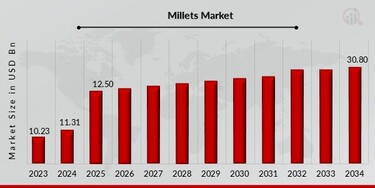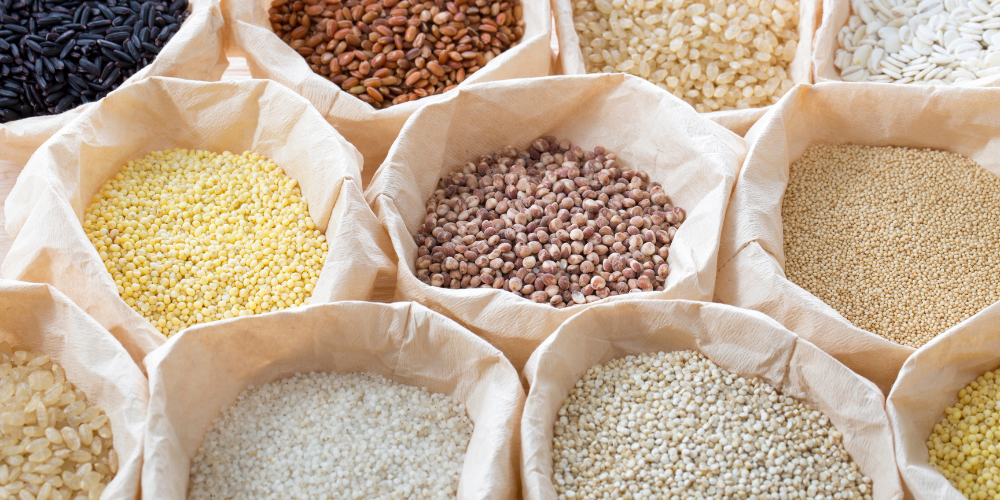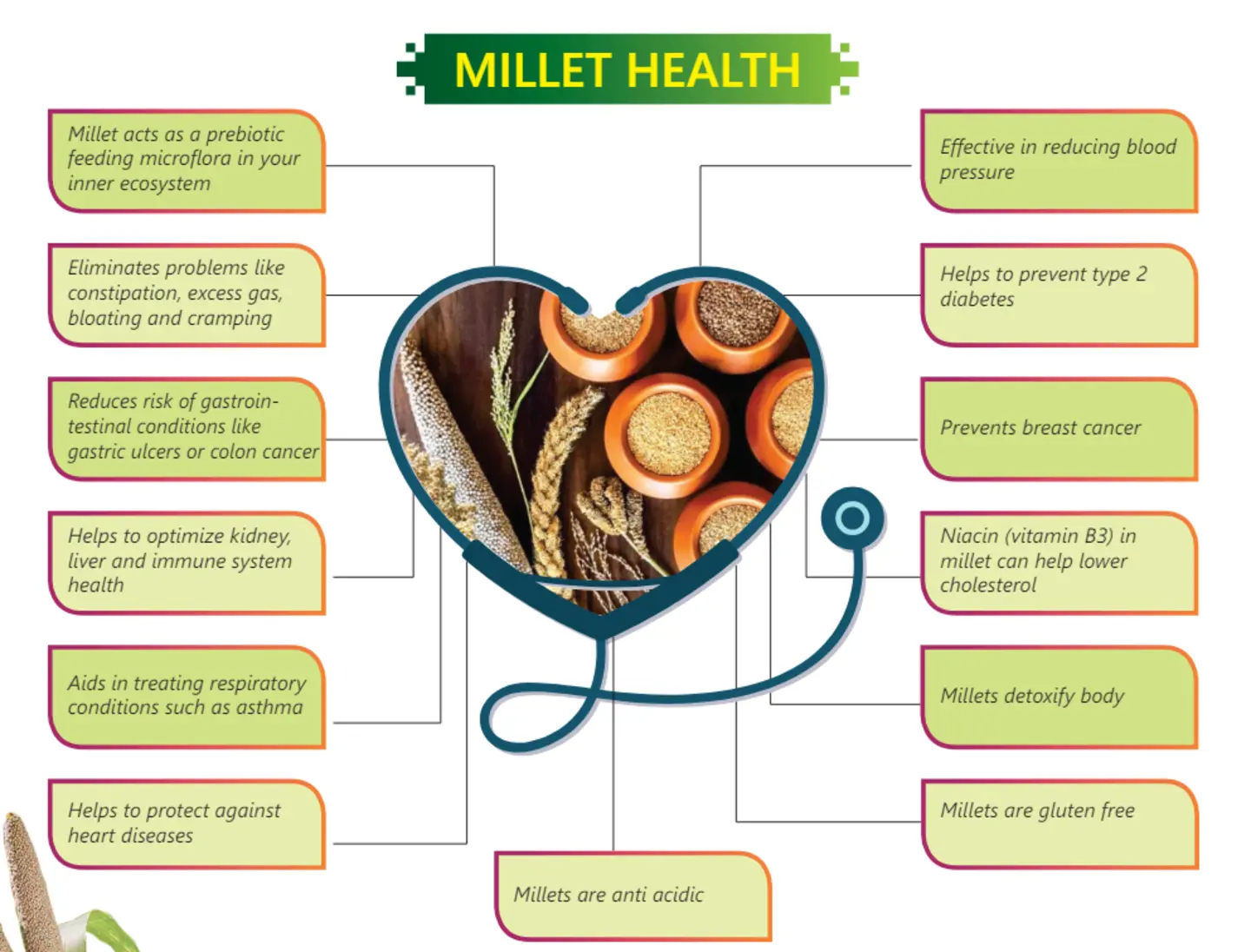Millet Market in India Trends & Growth
Explore the millet market in India, its growth potential, and business opportunities in this superfood sector!
Introduction
The millet market in India has witnessed remarkable growth in recent years. With increasing awareness about health and nutrition, millets have emerged as a superfood, driving demand both domestically and internationally. This article explores the current trends, growth potential, and business opportunities in the millet market in India.
What is Millet?

Millet is a highly nutritious, small-seeded grain that has been cultivated for thousands of years, primarily in Asia and Africa. It is a drought-resistant crop that thrives in arid and semi-arid regions, making it a sustainable food source. Millets are naturally gluten-free and rich in fiber, protein, vitamins, and essential minerals like iron, magnesium, and phosphorus. They are classified into major millets, such as Sorghum (Jowar), Pearl Millet (Bajra), and Finger Millet (Ragi), and minor millets, including Foxtail, Little, Barnyard, Proso, and Kodo millets. Due to their low glycemic index, millets are beneficial for diabetes management and weight loss. Additionally, they support heart health, digestion, and overall well-being. Their versatility allows them to be used in various traditional and modern recipes, including porridge, rotis, upma, and even snacks, making them an essential part of a balanced diet.
Millets are small-seeded grains that have been cultivated in India for centuries. They are known for their rich nutritional value and resilience to harsh climates. Millets are classified into two categories:
- Major Millets: Sorghum (Jowar), Pearl Millet (Bajra), and Finger Millet (Ragi).
- Minor Millets: Foxtail Millet (Kangni), Little Millet (Kutki), Barnyard Millet (Sanwa), Proso Millet (Chena), and Kodo Millet.
Nutritional Value of Millets
Millets are highly nutritious grains that are gaining popularity due to their rich health benefits. They are packed with essential nutrients such as fiber, protein, iron, calcium, magnesium, and antioxidants, making them a superior alternative to refined grains. Millets have a low glycemic index, making them ideal for diabetes management, while their high fiber content aids in digestion and weight control. Additionally, they are naturally gluten-free, making them a great choice for individuals with gluten intolerance. With increasing health awareness, the millet market in India is witnessing significant growth, as consumers are actively incorporating millets into their daily diets. The demand for millet-based products, such as flour, snacks, and ready-to-eat meals, is expanding rapidly, further driving the growth of the millet industry. As more people recognize the nutritional value of millets, their market potential in India continues to rise, offering new opportunities for farmers, food industries, and health-conscious consumers.
Historical Significance
Millets have played a crucial role in India’s agricultural and dietary history for thousands of years. These ancient grains were a staple food in Indian households before the Green Revolution, which led to the dominance of rice and wheat. Millets were widely consumed due to their resilience in dry and arid climates, making them a vital crop for food security. Traditionally, millets were used in making rotis, porridge, and fermented foods, forming a significant part of India’s culinary heritage. However, with the rise of modern agriculture, millet cultivation declined. Today, as people rediscover their health benefits, the millet market in India is experiencing a resurgence. Government initiatives, such as the promotion of millets as “nutri-cereals” and their inclusion in public distribution programs, have further fueled their revival. As awareness grows, millets are once again becoming a key component of India’s food industry, offering both nutritional and economic benefits to consumers and farmers alike.
Gluten-Free Nature
One of the key factors driving the growth of the millet market in India is the gluten-free nature of millets. Unlike wheat and other common grains, millets do not contain gluten, making them an excellent alternative for people with gluten intolerance or celiac disease. With an increasing number of consumers adopting gluten-free diets for better digestion and overall health, the demand for millets has surged in recent years. This shift has encouraged food manufacturers to develop a variety of millet-based products, such as millet flour, noodles, and snacks, catering to the health-conscious market. As awareness of gluten-related health issues grows, the millet market in India continues to expand, offering consumers a nutritious and easily digestible grain option while providing farmers and businesses with new opportunities in the food industry.
Climate Resilience
Millets are highly resilient to changing climatic conditions, making them a crucial crop in the millet market in India. Unlike rice and wheat, which require significant water and favorable weather conditions, millets thrive in arid and semi-arid regions with minimal irrigation. Their ability to withstand drought, high temperatures, and poor soil fertility makes them an ideal choice for Indian farmers facing climate uncertainties. As climate change impacts agriculture, millets offer a sustainable alternative that ensures food security and farmer livelihood. With the Indian government promoting millet cultivation to combat water scarcity and soil degradation, the millet market in India is experiencing renewed interest, contributing to both environmental sustainability and economic growth in the agricultural sector.
Versatile Culinary Use
valuable component of the millet market in India. These nutrient-rich grains can be used to prepare a variety of traditional and modern dishes, including rotis, dosas, upma, porridge, and even baked goods like cookies and cakes. With an increasing preference for healthy eating, food brands are introducing millet-based snacks, breakfast cereals, and ready-to-cook meals to cater to urban consumers. The adaptability of millets to different cuisines and cooking methods has fueled their demand in both household kitchens and the food industry. As more people explore millet-based diets, the millet market in India continues to expand, offering opportunities for innovation in millet-based food products.
Health Benefits
Regular consumption of millets helps in weight management, diabetes control, heart health, and improved digestion. Their high fiber content makes them beneficial for gut health.
Growing Popularity
With the rise of health-conscious consumers and government initiatives, millets are gaining popularity in urban as well as rural markets. They are now being incorporated into processed foods like snacks, cereals, and energy bars.
Millet Market in India: An Overview

India is the largest producer of millets globally, contributing significantly to global millet production. Government initiatives, health-conscious consumers, and a shift towards organic foods have driven the millet market in India.
The millet market in India has been experiencing significant growth due to rising health awareness, government initiatives, and a shift towards sustainable farming. As one of the largest producers of millets globally, India plays a crucial role in both domestic consumption and exports. The increasing demand for gluten-free and high-fiber grains has fueled millet-based product innovation, including snacks, flour, breakfast cereals, and ready-to-eat meals. Government programs such as the International Year of Millets (2023) and subsidies for millet farmers have further propelled the industry’s expansion. With growing urban adoption and millet integration into public food distribution schemes, the market holds immense potential for businesses and investors alike.
Trends in the Millet Market in India

The millet market in India is experiencing a transformation, driven by health-conscious consumers and government initiatives. The growing trend of organic and gluten-free diets has increased the demand for millets among urban populations. Additionally, millet-based food innovations, such as snacks, breakfast cereals, and ready-to-eat meals, are gaining popularity. The rise of e-commerce platforms has also expanded market reach, making millet products more accessible to consumers across the country. Furthermore, India’s focus on exporting millets to international markets like the USA, UAE, and Europe has opened new revenue streams. With continuous investment in millet processing technology and sustainable farming practices, the market is poised for significant growth in the coming years.
1. Growing Health Awareness
Consumers are increasingly adopting millet-based diets due to their high fiber content, protein, and gluten-free properties.
2. Rising Demand for Organic Millets
With the rise in organic farming and sustainability concerns, organic millet products are in high demand.
3. Expansion of Millet-Based Products
Millet-based snacks, flour, breakfast cereals, and instant mixes are becoming popular in urban markets.
4. Government Initiatives
The Indian government has launched programs like the National Year of Millets 2023 and subsidies to promote millet farming.
5. Export Growth
The export market for millets is expanding, with countries like the USA, UAE, and Europe importing Indian millets.
Growth Potential of the Millet Market in India

The millet market in India is poised for substantial growth due to shifting consumer preferences towards healthier food choices. The increasing urban demand for nutrient-dense, gluten-free grains has made millets a popular alternative to rice and wheat. Additionally, government initiatives such as the Millet Mission and inclusion of millets in public distribution systems (PDS) and mid-day meal programs are boosting consumption. Large-scale adoption by food processing companies for producing millet-based snacks, cereals, and beverages further enhances market potential. With technological advancements in millet farming, improved processing techniques, and rising exports, the industry is expected to witness exponential expansion in the coming years.
1. Increasing Urban Demand
Urban populations are shifting towards healthy eating habits, fueling millet demand.
2. Millet Inclusion in Government Schemes
Public distribution systems, mid-day meal programs, and health missions now include millets.
3. Adoption by Food Processing Companies
Big brands are launching millet-based biscuits, pasta, noodles, and ready-to-eat products.
4. Technological Advancements in Millet Farming
Improved irrigation techniques and hybrid seeds are enhancing millet yield and quality.
Business Opportunities in the Millet Market in India

The millet market in India presents lucrative business opportunities across various sectors, from farming to food processing and retail. With the increasing demand for healthy, gluten-free alternatives, entrepreneurs can venture into organic millet farming, capitalizing on government subsidies and incentives. Establishing millet processing units for producing flour, flakes, and instant mixes can be highly profitable. The rise of health-conscious consumers has also fueled the growth of millet-based food startups, offering snacks, breakfast cereals, and energy bars. Additionally, exporting Indian millets to international markets provides significant business potential, as global demand for nutrient-rich grains continues to rise. E-commerce and direct-to-consumer (DTC) models further enhance accessibility, allowing businesses to sell millet products directly to health-conscious customers, maximizing profitability.
1. Millet Farming
With government support and growing demand, millet farming is a lucrative business opportunity.
2. Millet Processing Units
Setting up processing units for millet flour, flakes, and ready-to-cook products can be profitable.
3. Millet-Based Food Startups
Startups focused on millet-based snacks, breakfast items, and beverages are gaining popularity.
4. Export Business
Indian millets are gaining traction in global markets, making exports a promising venture.
5. E-Commerce and Direct-to-Consumer (DTC) Model
Selling millet-based products online through e-commerce platforms offers high profit margins.
Challenges in the Millet Market in India
Despite the growing demand for millets, several challenges hinder the full potential of the millet market in India. One of the biggest hurdles is the lack of awareness, especially in rural areas where wheat and rice remain the preferred staple grains. Additionally, processing and storage present significant challenges, as millets have a shorter shelf life and require specialized equipment for dehusking and milling. The high cost of production compared to traditional grains also affects consumer affordability, making millets a premium product. Moreover, limited infrastructure and supply chain inefficiencies create bottlenecks in millet distribution, affecting both farmers and consumers. Lastly, despite government initiatives, the absence of a well-established marketing ecosystem for millets prevents farmers from getting fair prices. Addressing these challenges through better policies, investment in technology, and consumer education will be crucial in boosting the millet market in India.
1. Low Awareness in Rural Areas
Despite government efforts, rural areas still lack awareness about millet benefits.
2. Processing and Storage Issues
Millets require advanced processing and storage techniques to extend shelf life.
3. Competitive Market
With an increasing number of brands entering the market, competition is rising.
4. Higher Cost Compared to Traditional Grains
Millets are often priced higher than wheat and rice, making them less accessible for some consumers.
Future of the Millet Market in India
The millet market in India is set to grow exponentially. Factors such as rising health consciousness, government policies, and innovation in millet-based products will shape the future of the industry.
The future of the millet market in India looks highly promising, driven by rising health consciousness, government initiatives, and technological advancements in agriculture. With increasing consumer demand for nutrient-rich and gluten-free alternatives, millets are expected to become a mainstream dietary choice. The Indian government is actively promoting millet production through subsidies, awareness campaigns, and their inclusion in public welfare programs like mid-day meals. Additionally, the growing export potential for Indian millets in international markets is opening up new business opportunities. Innovations in millet-based processed foods, such as ready-to-eat snacks, flour blends, and beverages, are further fueling market expansion. Advancements in farming techniques, better supply chains, and collaborations between farmers and food processors will ensure sustained growth. As more consumers and businesses recognize the value of millets, this ancient grain is set to revolutionize the food industry in India and beyond.
1. Increasing Consumer Awareness and Demand
With social media, online health forums, and educational campaigns, more people are learning about the benefits of millet consumption. The trend towards plant-based and gluten-free diets will further drive millet demand.
2. Government Policies and Support
The Indian government is actively promoting millets through subsidies, awareness programs, and the integration of millets into public welfare schemes like mid-day meals and ration distribution.
3. Innovation in Millet-Based Products
Food industries are coming up with a variety of millet-based products, such as ready-to-eat meals, millet pasta, and millet-based beverages. This innovation will make millets more appealing to younger generations.
4. Expansion of the Export Market
With increasing demand for millets in international markets, India’s export sector is set to grow. Countries in Europe and North America are adopting millets for their health benefits, providing a huge opportunity for Indian exporters.
5. Improved Farming Techniques
Advancements in irrigation, organic farming, and better-quality seeds will lead to higher yield and better-quality millets, making them more accessible and affordable.
6. Rising Investment in Millet Startups
Venture capital firms and investors are recognizing the potential of the millet market, leading to increased investment in millet-based startups. This will drive further innovation and market expansion.
7. Millet Inclusion in Mainstream Diets
As more restaurants and food chains incorporate millet-based dishes into their menus, consumer habits will gradually shift, making millets a staple food.
8. Strengthening the Supply Chain
Investment in better storage facilities, processing techniques, and distribution channels will enhance the overall efficiency of the millet market, ensuring availability across all regions.
9. Collaboration Between Farmers and Food Processing Industries
Direct collaborations between millet farmers and food processing companies will help in reducing costs and increasing profitability, benefiting both parties.
10. Promotion Through Digital Marketing
With the rise of digital marketing and influencer collaborations, millet brands will reach a wider audience, boosting sales and awareness.
Conclusion
The millet market in India presents immense growth opportunities. Entrepreneurs, farmers, and investors can benefit from this expanding sector by tapping into the demand for nutritious and sustainable food options. As India continues to promote millet consumption, the future looks promising for this traditional yet modern superfood.



